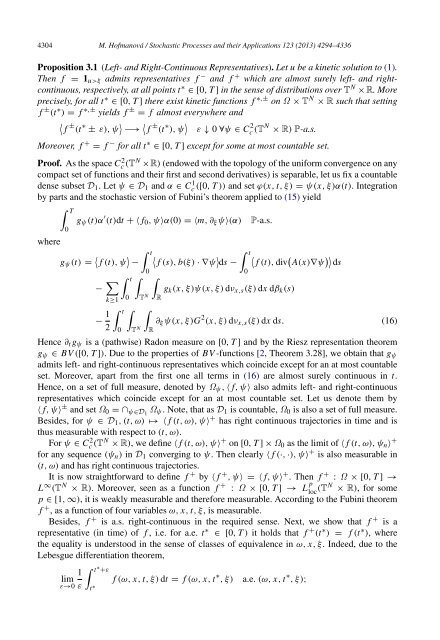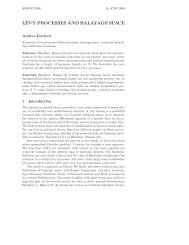Degenerate parabolic stochastic partial differential equations
Degenerate parabolic stochastic partial differential equations
Degenerate parabolic stochastic partial differential equations
Create successful ePaper yourself
Turn your PDF publications into a flip-book with our unique Google optimized e-Paper software.
4304 M. Hofmanová / Stochastic Processes and their Applications 123 (2013) 4294–4336<br />
Proposition 3.1 (Left- and Right-Continuous Representatives). Let u be a kinetic solution to (1).<br />
Then f = 1 u>ξ admits representatives f − and f + which are almost surely left- and rightcontinuous,<br />
respectively, at all points t ∗ ∈ [0, T ] in the sense of distributions over T N ×R. More<br />
precisely, for all t ∗ ∈ [0, T ] there exist kinetic functions f ∗,± on Ω × T N × R such that setting<br />
f ± (t ∗ ) = f ∗,± yields f ± = f almost everywhere and<br />
<br />
f ± (t ∗ ± ε), ψ −→ f ± (t ∗ ), ψ <br />
ε ↓ 0 ∀ψ ∈ C 2 c (TN × R) P-a.s.<br />
Moreover, f + = f − for all t ∗ ∈ [0, T ] except for some at most countable set.<br />
Proof. As the space Cc 2(TN ×R) (endowed with the topology of the uniform convergence on any<br />
compact set of functions and their first and second derivatives) is separable, let us fix a countable<br />
dense subset D 1 . Let ψ ∈ D 1 and α ∈ Cc 1 ([0, T )) and set ϕ(x, t, ξ) = ψ(x, ξ)α(t). Integration<br />
by parts and the <strong>stochastic</strong> version of Fubini’s theorem applied to (15) yield<br />
where<br />
T<br />
0<br />
g ψ (t)α ′ (t)dt + ⟨ f 0 , ψ⟩α(0) = ⟨m, ∂ ξ ψ⟩(α)<br />
g ψ (t) = f (t), ψ −<br />
− k≥1<br />
− 1 2<br />
t<br />
0<br />
t T N<br />
0<br />
t T N<br />
0<br />
P-a.s.<br />
<br />
t <br />
f (s), b(ξ) · ∇ψ ds − f (t), div A(x)∇ψ ds<br />
g k (x, ξ)ψ(x, ξ) dν x,s (ξ) dx dβ k (s)<br />
R<br />
0<br />
∂ ξ ψ(x, ξ)G 2 (x, ξ) dν x,s (ξ) dx ds. (16)<br />
R<br />
Hence ∂ t g ψ is a (pathwise) Radon measure on [0, T ] and by the Riesz representation theorem<br />
g ψ ∈ BV ([0, T ]). Due to the properties of BV -functions [2, Theorem 3.28], we obtain that g ψ<br />
admits left- and right-continuous representatives which coincide except for an at most countable<br />
set. Moreover, apart from the first one all terms in (16) are almost surely continuous in t.<br />
Hence, on a set of full measure, denoted by Ω ψ , ⟨ f, ψ⟩ also admits left- and right-continuous<br />
representatives which coincide except for an at most countable set. Let us denote them by<br />
⟨ f, ψ⟩ ± and set Ω 0 = ∩ ψ∈D1 Ω ψ . Note, that as D 1 is countable, Ω 0 is also a set of full measure.<br />
Besides, for ψ ∈ D 1 , (t, ω) → ⟨ f (t, ω), ψ⟩ + has right continuous trajectories in time and is<br />
thus measurable with respect to (t, ω).<br />
For ψ ∈ Cc 2(TN × R), we define ⟨ f (t, ω), ψ⟩ + on [0, T ] × Ω 0 as the limit of ⟨ f (t, ω), ψ n ⟩ +<br />
for any sequence (ψ n ) in D 1 converging to ψ. Then clearly ⟨ f (·, ·), ψ⟩ + is also measurable in<br />
(t, ω) and has right continuous trajectories.<br />
It is now straightforward to define f + by ⟨ f + , ψ⟩ = ⟨ f, ψ⟩ + . Then f + : Ω × [0, T ] →<br />
L ∞ (T N × R). Moreover, seen as a function f + : Ω × [0, T ] → L p loc (TN × R), for some<br />
p ∈ [1, ∞), it is weakly measurable and therefore measurable. According to the Fubini theorem<br />
f + , as a function of four variables ω, x, t, ξ, is measurable.<br />
Besides, f + is a.s. right-continuous in the required sense. Next, we show that f + is a<br />
representative (in time) of f , i.e. for a.e. t ∗ ∈ [0, T ) it holds that f + (t ∗ ) = f (t ∗ ), where<br />
the equality is understood in the sense of classes of equivalence in ω, x, ξ. Indeed, due to the<br />
Lebesgue differentiation theorem,<br />
1<br />
lim<br />
ε→0 ε<br />
t ∗ +ε<br />
t ∗ f (ω, x, t, ξ) dt = f (ω, x, t ∗ , ξ) a.e. (ω, x, t ∗ , ξ);



